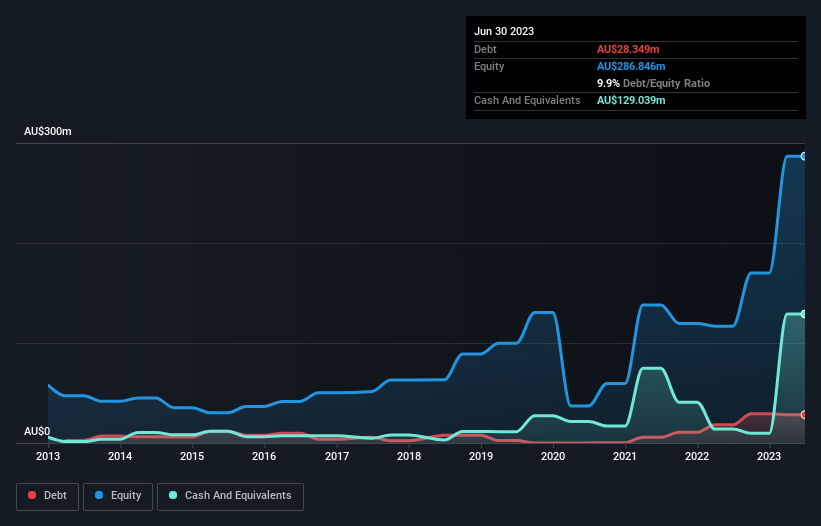The external fund manager backed by Berkshire Hathaway's Charlie Munger, Li Lu, makes no bones about it when he says 'The biggest investment risk is not the volatility of prices, but whether you will suffer a permanent loss of capital.' So it seems the smart money knows that debt - which is usually involved in bankruptcies - is a very important factor, when you assess how risky a company is. We can see that Strike Energy Limited (ASX:STX) does use debt in its business. But the more important question is: how much risk is that debt creating?
Why Does Debt Bring Risk?
Debt assists a business until the business has trouble paying it off, either with new capital or with free cash flow. Part and parcel of capitalism is the process of 'creative destruction' where failed businesses are mercilessly liquidated by their bankers. However, a more common (but still painful) scenario is that it has to raise new equity capital at a low price, thus permanently diluting shareholders. By replacing dilution, though, debt can be an extremely good tool for businesses that need capital to invest in growth at high rates of return. When we examine debt levels, we first consider both cash and debt levels, together.
See our latest analysis for Strike Energy
How Much Debt Does Strike Energy Carry?
You can click the graphic below for the historical numbers, but it shows that as of June 2023 Strike Energy had AU$28.3m of debt, an increase on AU$18.3m, over one year. But on the other hand it also has AU$129.0m in cash, leading to a AU$100.7m net cash position.

A Look At Strike Energy's Liabilities
According to the last reported balance sheet, Strike Energy had liabilities of AU$22.8m due within 12 months, and liabilities of AU$32.2m due beyond 12 months. Offsetting these obligations, it had cash of AU$129.0m as well as receivables valued at AU$1.02m due within 12 months. So it can boast AU$75.0m more liquid assets than total liabilities.
This short term liquidity is a sign that Strike Energy could probably pay off its debt with ease, as its balance sheet is far from stretched. Succinctly put, Strike Energy boasts net cash, so it's fair to say it does not have a heavy debt load! There's no doubt that we learn most about debt from the balance sheet. But ultimately the future profitability of the business will decide if Strike Energy can strengthen its balance sheet over time. So if you're focused on the future you can check out this free report showing analyst profit forecasts.
Since Strike Energy doesn't have significant operating revenue, shareholders must hope it'll sell some fossil fuels, before it runs out of money.
So How Risky Is Strike Energy?
Statistically speaking companies that lose money are riskier than those that make money. And the fact is that over the last twelve months Strike Energy lost money at the earnings before interest and tax (EBIT) line. And over the same period it saw negative free cash outflow of AU$80m and booked a AU$18m accounting loss. However, it has net cash of AU$100.7m, so it has a bit of time before it will need more capital. Overall, its balance sheet doesn't seem overly risky, at the moment, but we're always cautious until we see the positive free cash flow. When analysing debt levels, the balance sheet is the obvious place to start. But ultimately, every company can contain risks that exist outside of the balance sheet. To that end, you should learn about the 3 warning signs we've spotted with Strike Energy (including 1 which is significant) .
When all is said and done, sometimes its easier to focus on companies that don't even need debt. Readers can access a list of growth stocks with zero net debt 100% free, right now.
New: Manage All Your Stock Portfolios in One Place
We've created the ultimate portfolio companion for stock investors, and it's free.
• Connect an unlimited number of Portfolios and see your total in one currency
• Be alerted to new Warning Signs or Risks via email or mobile
• Track the Fair Value of your stocks
Have feedback on this article? Concerned about the content? Get in touch with us directly. Alternatively, email editorial-team (at) simplywallst.com.
This article by Simply Wall St is general in nature. We provide commentary based on historical data and analyst forecasts only using an unbiased methodology and our articles are not intended to be financial advice. It does not constitute a recommendation to buy or sell any stock, and does not take account of your objectives, or your financial situation. We aim to bring you long-term focused analysis driven by fundamental data. Note that our analysis may not factor in the latest price-sensitive company announcements or qualitative material. Simply Wall St has no position in any stocks mentioned.
About ASX:STX
Strike Energy
An independent gas producer, explores for and develops oil and gas resources in Australia.
Good value with adequate balance sheet.
Similar Companies
Market Insights
Community Narratives




